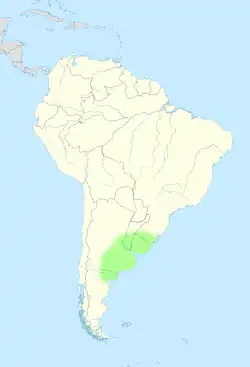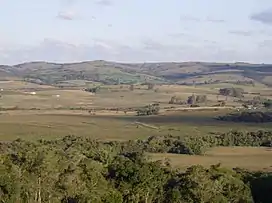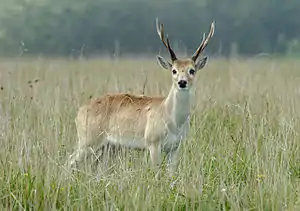Pampas | |
|---|---|
Natural region | |
 Landscape in the Pampas at eye level. Brazil | |
 Approximate location and borders of the Pampas encompassing the southeastern area of South America bordering the Atlantic Ocean | |
| Coordinates: 35°S 62°W / 35°S 62°W | |
| Countries | |
| Elevation | 160 m (520 ft) |
| Population | |
| • Total | 43,909,235 |
The Pampas (from the Quechua: pampa, meaning "plain") are fertile South American low grasslands that cover more than 1,200,000 square kilometres (460,000 sq mi) and include the Argentine provinces of Buenos Aires, La Pampa, Santa Fe, Entre Ríos, and Córdoba; all of Uruguay; and Brazil's southernmost state, Rio Grande do Sul. The vast plains are a natural region, interrupted only by the low Ventana and Tandil hills, near Bahía Blanca and Tandil (Argentina), with a height of 1,300 m (4,265 ft) and 500 m (1,640 ft), respectively.
The climate is temperate, with precipitation of 600 to 1,200 mm (23.6 to 47.2 in) that is more or less evenly distributed throughout the year, making the soils appropriate for agriculture. The area is also one of the distinct physiography provinces of the larger Paraná–Paraguay plain division.
Topography
This region has generally low elevations, whose highest levels generally do not exceed 600 metres (1,970 feet) in altitude. The coastal areas and most of the Buenos Aires Province are predominantly plain (with some wetlands) and the interior areas (mainly in the southern part of the Brazilian state of Rio Grande do Sul and Uruguay) have low ranges of hills (like Serras de Sudeste in Brazil and Cuchilla Grande in Uruguay). Low hills covered by grasslands are called coxilhas (Portuguese pronunciation: [koˈʃiʎɐs]) in Portuguese and cuchillas (Spanish pronunciation: [kuˈtʃiʝas]) in Spanish, and it is the most typical landscape of the countryside areas in the northern parts of the Pampas. The highest elevations of the Pampas region are found in the Sierra de la Ventana mountains, in the southern part of Buenos Aires Province, with 1,239 m (4,065 ft) at the summit of Cerro Tres Picos.

Climates
The climate of the Pampas is generally temperate, gradually giving way to a more humid subtropical climate in the north (Cfa, according to the Köppen climate classification, with a Cwa tendency (drier winters) in the northwestern edge); a cold semi-arid climate (BSk) on the southern and western fringes (like San Luis Province, western La Pampa Province and southern Buenos Aires Province); and an oceanic climate (Cfb) in the southeastern part (in the localities of Mar del Plata, Necochea, Tandil and the Sierra de la Ventana mountains, Argentina). Summer temperatures are more uniform than winter temperatures, generally ranging from 28 to 33 °C (82 to 91 °F) during the day. However, most cities in the Pampas occasionally have high temperatures that push 38 °C (100 °F), as occurs when warm, dry, northerly winds blow from southern Brazil, northern Argentina or Paraguay. Autumn arrives gradually in March and peaks in April and May. In April, highs range from 20 to 25 °C (68 to 77 °F) and lows from 9 to 13 °C (48 to 55 °F). The first frosts arrive in mid-April in the south and late May or early June in the north.

Winters are generally mild, but cold waves often occur. Typical temperatures range from 12 to 19 °C (54 to 66 °F) during the day, and from 1 to 6 °C (34 to 43 °F) at night. With strong northerly winds, days of over 25 °C (77 °F) can be recorded almost everywhere, and during cold waves, high temperatures can be only 6 °C (43 °F). Frost occurs everywhere in the Pampas, but it is much more frequent in the southwest than around the Parana and Uruguay Rivers. Temperatures under −5 °C (23 °F) can occur everywhere, but values of −10 °C (14 °F) or lower are confined to the south and west. Snow almost never falls in the northernmost third and is rare and light elsewhere, except for exceptional events in which depths have reached 30 cm (12 in). Springs are very variable; it is warmer than fall in most areas (especially in the west) but significantly colder along the Atlantic. Violent storms are more common as well as wide temperature variations: days of 35 °C (95 °F) can give way to nights of under 5 °C (41 °F) or even frost, all within only a few days.
Precipitation ranges from 1,400 millimetres (55 in) in the northeast to about 400 millimetres (16 in) or less in the southern and western edges. It is highly seasonal in the West, with some places recording averages of 120 mm (4.7 in) monthly in the summer, and only 20 millimeters (0.8 in) monthly in the winter. The eastern areas have small peaks in the fall and the spring, with relatively rainy summers and winters that are only slightly drier. However, where summer rain falls as short, heavy storms, winter rain falls mostly as cold drizzle, and so the amount of rainy days is fairly constant. Very intense thunderstorms are common in the spring and summer, and it has among the most frequent lightning and highest convective cloud tops in the world.[1][2] The severe thunderstorms produce intense hailstorms, both floods and flash floods, and the most consistently active tornado region outside the central and southeastern US.[3]
Climate charts
Climate charts for different locations of the Pampas:
| Bagé, Rio Grande do Sul, Brazil (1981-2010) | ||||||||||||||||||||||||||||||||||||||||||||||||||||||||||||
|---|---|---|---|---|---|---|---|---|---|---|---|---|---|---|---|---|---|---|---|---|---|---|---|---|---|---|---|---|---|---|---|---|---|---|---|---|---|---|---|---|---|---|---|---|---|---|---|---|---|---|---|---|---|---|---|---|---|---|---|---|
| Climate chart (explanation) | ||||||||||||||||||||||||||||||||||||||||||||||||||||||||||||
| ||||||||||||||||||||||||||||||||||||||||||||||||||||||||||||
| ||||||||||||||||||||||||||||||||||||||||||||||||||||||||||||
| Santa Vitória do Palmar, Rio Grande do Sul, Brazil (1981-2010) | ||||||||||||||||||||||||||||||||||||||||||||||||||||||||||||
|---|---|---|---|---|---|---|---|---|---|---|---|---|---|---|---|---|---|---|---|---|---|---|---|---|---|---|---|---|---|---|---|---|---|---|---|---|---|---|---|---|---|---|---|---|---|---|---|---|---|---|---|---|---|---|---|---|---|---|---|---|
| Climate chart (explanation) | ||||||||||||||||||||||||||||||||||||||||||||||||||||||||||||
| ||||||||||||||||||||||||||||||||||||||||||||||||||||||||||||
| ||||||||||||||||||||||||||||||||||||||||||||||||||||||||||||
| Buenos Aires, Argentina (1981-2010) | ||||||||||||||||||||||||||||||||||||||||||||||||||||||||||||
|---|---|---|---|---|---|---|---|---|---|---|---|---|---|---|---|---|---|---|---|---|---|---|---|---|---|---|---|---|---|---|---|---|---|---|---|---|---|---|---|---|---|---|---|---|---|---|---|---|---|---|---|---|---|---|---|---|---|---|---|---|
| Climate chart (explanation) | ||||||||||||||||||||||||||||||||||||||||||||||||||||||||||||
| ||||||||||||||||||||||||||||||||||||||||||||||||||||||||||||
| ||||||||||||||||||||||||||||||||||||||||||||||||||||||||||||
| Punta del Este, Uruguay (1961-1990) | ||||||||||||||||||||||||||||||||||||||||||||||||||||||||||||
|---|---|---|---|---|---|---|---|---|---|---|---|---|---|---|---|---|---|---|---|---|---|---|---|---|---|---|---|---|---|---|---|---|---|---|---|---|---|---|---|---|---|---|---|---|---|---|---|---|---|---|---|---|---|---|---|---|---|---|---|---|
| Climate chart (explanation) | ||||||||||||||||||||||||||||||||||||||||||||||||||||||||||||
| ||||||||||||||||||||||||||||||||||||||||||||||||||||||||||||
| ||||||||||||||||||||||||||||||||||||||||||||||||||||||||||||
| Viedma, Argentina (1981-2010) | ||||||||||||||||||||||||||||||||||||||||||||||||||||||||||||
|---|---|---|---|---|---|---|---|---|---|---|---|---|---|---|---|---|---|---|---|---|---|---|---|---|---|---|---|---|---|---|---|---|---|---|---|---|---|---|---|---|---|---|---|---|---|---|---|---|---|---|---|---|---|---|---|---|---|---|---|---|
| Climate chart (explanation) | ||||||||||||||||||||||||||||||||||||||||||||||||||||||||||||
| ||||||||||||||||||||||||||||||||||||||||||||||||||||||||||||
| ||||||||||||||||||||||||||||||||||||||||||||||||||||||||||||
| Coronel Suárez, Buenos Aires, Argentina (1981-2010) | ||||||||||||||||||||||||||||||||||||||||||||||||||||||||||||
|---|---|---|---|---|---|---|---|---|---|---|---|---|---|---|---|---|---|---|---|---|---|---|---|---|---|---|---|---|---|---|---|---|---|---|---|---|---|---|---|---|---|---|---|---|---|---|---|---|---|---|---|---|---|---|---|---|---|---|---|---|
| Climate chart (explanation) | ||||||||||||||||||||||||||||||||||||||||||||||||||||||||||||
| ||||||||||||||||||||||||||||||||||||||||||||||||||||||||||||
| ||||||||||||||||||||||||||||||||||||||||||||||||||||||||||||
| Laboulaye, Córdoba, Argentina (1991-2020) | ||||||||||||||||||||||||||||||||||||||||||||||||||||||||||||
|---|---|---|---|---|---|---|---|---|---|---|---|---|---|---|---|---|---|---|---|---|---|---|---|---|---|---|---|---|---|---|---|---|---|---|---|---|---|---|---|---|---|---|---|---|---|---|---|---|---|---|---|---|---|---|---|---|---|---|---|---|
| Climate chart (explanation) | ||||||||||||||||||||||||||||||||||||||||||||||||||||||||||||
| ||||||||||||||||||||||||||||||||||||||||||||||||||||||||||||
| ||||||||||||||||||||||||||||||||||||||||||||||||||||||||||||
Wildlife
Human activity has caused major changes to the wildlife of the Pampas. Most big or medium-sized species such as puma, rhea, Capybara, plains viscacha, maned wolf, marsh deer and Pampas deer have lost their habitats especially due to the spread of agriculture and ranching, and are only present in very few relicts of the pampas.[4] Other species, such as the Jaguar and the Guanaco have been extirpated completely from this habitat.
Mammals that are still fairly present include Brazilian guinea pig, southern mountain cavy, coypu, Pampas fox, Geoffroy's cat, lesser grison, white-eared opossum, Molina's hog-nosed skunk, big lutrine opossum, big hairy armadillo and southern long-nosed armadillo. Bird species of the pampas are ruddy-headed goose, pampas meadowlark, hudsonian godwit, maguari stork, white-faced ibis, white-winged coot, southern screamer, dot-winged crake, curve-billed reedhaunter, burrowing owl and the rhea.[5][6][7][8][9] Invasive species include the European hare, wild boar and house sparrow.
 Pampas deer
Pampas deer Pampas fox
Pampas fox.JPG.webp) Rhea
Rhea.JPG.webp) Southern screamer
Southern screamer.jpg.webp) Gilded hummingbird
Gilded hummingbird
Vegetation
| Regions of Argentina |
|---|
Historically, frequent wildfires ensured that only small plants such as grasses flourished, while trees were less common. The dominant vegetation types are grassy prairie and grass steppe, in which numerous species of the grass genus Stipa are particularly conspicuous. "Pampas grass" (Cortaderia selloana) is an iconic species of the Pampas. Vegetation typically includes perennial grasses and herbs. Different strata of grasses occur because of gradients of water availability.
The World Wildlife Fund divides the Pampas into three distinct ecoregions. The Uruguayan Savanna lies east of the Paraná River, and includes all of Uruguay, most of Entre Ríos and Corrientes provinces in Argentina, and the southern portion of Brazil's state of Rio Grande do Sul. The Humid Pampas include eastern Buenos Aires Province, and southern Entre Ríos Province. The Semiarid Pampas includes western Buenos Aires Province and adjacent portions of Santa Fe, Córdoba, and La Pampa provinces. The Pampas are bounded by the drier Argentine Espinal grasslands, which form a semicircle around the north, west, and south of the Humid Pampas.
Winters are cold to mild, and summers are hot and humid. Rainfall is fairly uniform throughout the year but is a little heavier during the summer. Annual rainfall is heaviest near the coast and decreases gradually further inland. Rain during the late spring and summer usually arrives in the form of brief heavy showers and thunderstorms. More general rainfall occurs the remainder of the year as cold fronts and storm systems move through. Although cold spells during the winter often send nighttime temperatures below freezing, snow is quite rare. In most winters, a few light snowfalls occur over inland areas.
Central Argentina boasts a successful agricultural business, with crops grown on the Pampas south and west of Buenos Aires. Much of the area is also used for cattle, and more recently, to cultivate vineyards in the Buenos Aires wine region. The area is also used for farming honey using European honeybees. These farming regions are particularly susceptible to flooding during thunderstorms. The weather averages out to be 60 °F (16 °C) year-round in the Pampas.

Population
 Argentina
Argentina
 Buenos Aires 17,196,396
Buenos Aires 17,196,396 Córdoba 3,683,937
Córdoba 3,683,937 Santa Fe 3,481,514
Santa Fe 3,481,514 City of Buenos Aires 3,068,043
City of Buenos Aires 3,068,043 Entre Ríos 1,360,443
Entre Ríos 1,360,443 La Pampa 352,378
La Pampa 352,378
 Brazil
Brazil
 Rio Grande do Sul 11,247,972
Rio Grande do Sul 11,247,972
 Uruguay
Uruguay
- All departments 3,518,552
- Total Population 43,909,235
Immigration
Starting in the 1840s but intensifying after the 1880s, European immigrants began to migrate to the Pampas, first as part of government-sponsored colonization schemes to settle the land and later as tenant farmers "working as either a sharecropper or as paid laborers for absentee landowners"[10] in an attempt to make a living for themselves.
However, many immigrants eventually moved to more permanent employment in cities, as industrialization picked up after the 1930s. As a result, Argentina's history of immigration in Buenos Aires Province is typically associated with cities and urban life, unlike in Entre Ríos Province and Santa Fe Province, where European immigration took on a more rural profile.
See also
- Dry Pampa
- Estancia
- Federal University of Pampa
- Gaucho
- Humid Pampas
- José Froilán González - the "Pampas Bull"
- Luis Ángel Firpo - the "Wild Bull of Las Pampas"
- Médanos (dunes)
- Médanos wines
- Riograndense Republic
- Southern Cone
- South American jaguar
References
- ↑ Zipser, E. J.; C. Liu; D. J. Cecil; S. W. Nesbitt; D. P. Yorty (2006). "Where are the Most Intense Thunderstorms on Earth?" (PDF). Bull. Am. Meteorol. Soc. 87 (8): 1057–1071. Bibcode:2006BAMS...87.1057Z. doi:10.1175/BAMS-87-8-1057. S2CID 51044775. Archived from the original (PDF) on 2020-08-06.
- ↑ Virts, Katrina S.; J. M. Wallace; M. L. Hutchins; R. H. Holzworth (2013). "Highlights of a New Ground-Based, Hourly Global Lightning Climatology". Bull. Am. Meteorol. Soc. 94 (9): 1381–91. Bibcode:2013BAMS...94.1381V. doi:10.1175/BAMS-D-12-00082.1. S2CID 73647974.
- ↑ Rasmussen, Kristen L.; M. D. Zuluaga; R. A. Houze Jr. (2014). "Severe convection and lightning in subtropical South America". Geophys. Res. Lett. 41 (20): 7359–66. Bibcode:2014GeoRL..41.7359R. doi:10.1002/2014GL061767.
- ↑ "Southern South America: Southeastern Argentina | Ecoregions | WWF". World Wildlife Fund. Retrieved 2020-02-20.
- ↑ WWF ecoregions: https://www.worldwildlife.org/ecoregions/nt0803
- ↑ IUCN redlist: http://oldredlist.iucnredlist.org/details/6786/0%5B%5D
- ↑ IUCN redlist: http://oldredlist.iucnredlist.org/details/4819/0%5B%5D
- ↑ IUCN redlist: http://oldredlist.iucnredlist.org/details/22689353/0%5B%5D
- ↑ IUCN redlist: http://oldredlist.iucnredlist.org/details/29620/0%5B%5D
- ↑ Meade, Teresa A. History of modern Latin America: 1800 to the present. Wiley Blackwell, 2016.